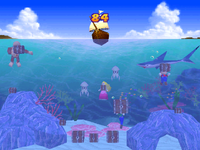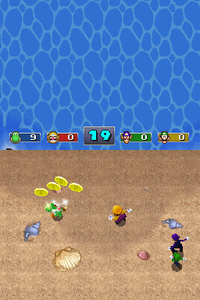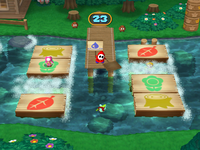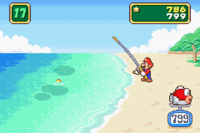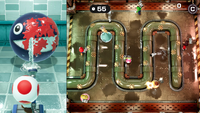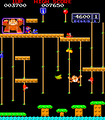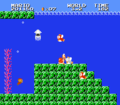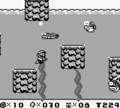Water
This article is under construction. Therefore, please excuse its informal appearance while it is being worked on. We hope to have it completed as soon as possible.
- This article is about the obstacle in the Super Mario franchise. For the item in Paper Mario, see Water (item).
| Water | |||
|---|---|---|---|
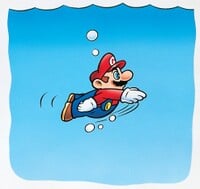 Artwork of Mario swimming in water from Super Mario World | |||
| First appearance | Donkey Kong Jr. (1982) | ||
| Latest appearance | Super Mario Galaxy + Super Mario Galaxy 2 (2025) | ||
| |||
In the Super Mario franchise, water frequently serves as a means of movement for the player, as an obstacle, and as a level theme. When entered, water can typically be navigated by swimming through it. It often appears colored light blue, dark blue, or clear. Water can contain a variety of enemies, such as Cheep Cheeps, Bloopers, Urchins, and Cheep Chomps.
History[edit]
Donkey Kong franchise[edit]
Donkey Kong Jr.[edit]
In Donkey Kong Jr., the Vine Scene contains water at the bottom of the screen. In this appearance, it serves as a pit.
Donkey Kong (Game Boy)[edit]
Water appears in several stages of the Game Boy version of Donkey Kong. Mario can enter water and swim through it. However, enemies such as Bukubuku and Gessori can be found in water.
Donkey Kong Bananza[edit]
In Donkey Kong Bananza, water is a type of terrain classified as "extra soft". Individual bodies and streams of water occasionally appear, which Donkey Kong can destroy by moving into it or inhaling it using the Elephant Bananza. Water can be continuously destroyed if Donkey Kong stands below a water stream.
Large bodies of indestructible water also appear in layers such as the Lagoon Layer and the Resort Layer. Donkey Kong may swim through or Surf Surf on it, or dash on top of the water surface using Zebra Bananza. Inhaling these bodies of water using the Elephant Bananza does not destroy the water, but still allows Donkey Kong to store spheres of water in his trunk.
Being in contact with water turns lava into obsidian. Water also conducts electricity, allowing an electric current to run through a body of water. In the Freezer Layer, water is cold and deals freezing damage when Donkey Kong is in contact with it.
Super Mario series[edit]
Super Mario Bros. / Super Mario Bros.: The Lost Levels[edit]
In Super Mario Bros., water first appears in World 2-2. Enemies such as Bloobers and Cheep Cheeps are commonly found in the game's underwater levels. A smaller body of water that does not take up an entire section of the level also appears in World 3-1. This type of water cannot be swum in, and it instead serves as a type of bottomless pit, causing Mario and Luigi to lose a life if they fall in.
Small, non-interactable bodies of water reappear in numerous levels in Super Mario Bros.: The Lost Levels, starting in World 1-2, though in the Super Mario All-Stars version, this type of water first appears in World 2-1 instead (as the water in the former level is either replaced with lava or even removed altogether). Water that can be swum in and that takes up entire sections of levels also reappears, starting in World 3-2.
In the original Nintendo Entertainment System versions of these games, water uses the same graphics as lava but colored blue instead of red. Small bodies of water are functionally identical to lava as well, since Mario and Luigi can fall through them and lose a life.
Super Mario Bros. 2[edit]
Non-interactable bodies of water also appear in various levels in Super Mario Bros. 2, such as World 4-1, where they function as a type of bottomless pit. Waterfalls are present in some levels, but are likewise non-interactable. Trouters are a notable water enemy, usually found jumping in and out of water. Whales are found exclusively in World 4-2, where they can serve as platforms to cross large bodies of water. Whales will also occasionally spray water out of their blow holes, which can be used to reach higher places. However, touching these water sprays from the sides causes the player to take damage.
Super Mario Bros. 3[edit]
Water appears in many levels throughout Super Mario Bros. 3, first seen in World 1-5. Water can be found scattered in small pools in the ground, or taking up entire levels, and can be swum in in either case, as is the case for most games thereafter. Some levels such as World 4-1 feature water being poured out of pipes, which can also be swum in. In some cases, water contains enemies such as Boss Bass, Lava Lotus, and Jelectros.
Super Mario Land[edit]
In Super Mario Land, water is present in every level of the Muda Kingdom. Unlike in other Super Mario games, Mario cannot swim in water and will lose a life if he falls into it in an on-land level. Mario uses the Marine Pop to traverse levels that are submerged in water.
Super Mario World[edit]
In Super Mario World, water first appears in Yoshi's Island 4, taking up the bottom part of the screen. It appears in many later levels as well, either placing the whole level underwater, or set in only in small sections.
Super Mario Land 2: 6 Golden Coins[edit]
In Super Mario Land 2: 6 Golden Coins, water first appears in the Hippo stage, taking up much of the level, though the player is able to jump across platforms above it. It also makes prominent appearances in the Turtle Zone and the Macro Zone's In the Syrup Sea stage.
Super Mario 64 / Super Mario 64 DS[edit]
Water is a common world element in Super Mario 64 and Super Mario 64 DS. It first appears in the moat of the Mushroom Castle, and it appears many times in some of the levels themselves, such as Jolly Roger Bay, the Hazy Maze Cave, and Wet-Dry World. When Mario becomes Metal Mario, he is able to walk under the water as he would on dry land. In lieu of an air meter, water slowly drains Mario's Power Meter if he is below its surface by one sector every eight seconds, and it restores his Power Meter if he is at the surface.
Snowman's Land also contains a hazardous type of water known as freezing water.
Super Mario Sunshine[edit]
Water is a central game mechanic, as well as an obstacle and world element in Super Mario Sunshine. Mario can spray water using FLUDD, which is necessary to interact with many objects and enemies in the game, most notably to clean up goop. Splashes of water like those produced by FLUDD can also be produced by breaking Water Barrels, dripping off Mario for a short time after he exits a body of water, and by Yoshis briefly before disappearing if they run out of juice (which itself functions mostly the same as FLUDD’s sprayed water, but with additional effects). These splashes of water annoy Piantas and most other friendly characters if they come into contact with them, causing them to become angry at Mario.
FLUDD has a limited water tank, which can be refilled in bodies of water or by picking up Water Bottles and coming into contact with water fountains found in some areas. Bodies of water appear in almost every level, particularly in the ocean around the edges of Isle Delfino. Water now drains Mario's air meter when he is below the surface in place of his Health Meter, and his air meter is restored if he is above the water's surface. If Mario enters water deep enough to swim in while riding a Yoshi, or dismounts a Yoshi in shallow water, the Yoshi disappears.
Bianco Hills, Ricco Harbor, and Noki Bay also contain slimy water in certain episodes. Slimy water deals damage to Mario if he stays on its surface, but it can be swum in normally (draining Mario's air meter) if he stays below the surface. Similarly, a substance known as hot water appears during the game's final boss battle against Bowser and Bowser Jr., which causes Mario to recoil and take damage on contact. Despite its name, hot water does not resemble either real-world water or the game's ordinary water and appears to be a type of green slime.
New Super Mario Bros.[edit]
Water appears most commonly in New Super Mario Bros. in World 3, which mainly consists of beach-themed levels. However, water also appears in some levels outside World 3 as a key component.
Super Mario Galaxy[edit]
Stages dedicated to water appear in Super Mario Galaxy, such as Beach Bowl Galaxy, which mainly contains water-based missions.
New Super Mario Bros. Wii[edit]
Water appears most commonly in New Super Mario Bros. Wii in World 4, which mainly consists of beach-themed levels that contain water. However, water also appears in some levels outside World 4 as a key component. Some levels of World 7 contain floating bubbles of water.
Super Mario Galaxy 2[edit]
Stages dedicated to water appear in Super Mario Galaxy 2, such as Cosmic Cove Galaxy, which mainly contains water-based missions.
Super Mario 3D Land[edit]
Water appears occasionally in Super Mario 3D Land, in levels such as World 3-2.
New Super Mario Bros. 2[edit]
Water appears most commonly in New Super Mario Bros. 2 in World 3, which partially consists of beach-themed levels that contain water. However, water also appears in some levels outside World 3 as a key component.
New Super Mario Bros. U[edit]
Water appears most commonly in New Super Mario Bros. U in Sparkling Waters, which mainly consists of beach-themed levels that contain water. However, water also appears in some levels outside of Sparkling Waters as a key component.
Super Mario Odyssey[edit]
In Super Mario Odyssey, water is everywhere. More specifically, it is first encountered all the way in the first kingdom, the Cap Kingdom, inside Top-Hat Tower. Bodies of water can be found in nearly every kingdom. The only exceptions are the Cloud Kingdom, Lost Kingdom, Ruined Kingdom, Luncheon Kingdom, Moon Kingdom, and Dark Side. Even still, the Lake Kingdom and Seaside Kingdom center on water based exploration, being based more upon exploring beneath the waves than on dry land. The Snow Kingdom's wide freezing water is a perennial obstacle. As with the games Super Mario Odyssey follows up from, those being Super Mario 64 and Super Mario Sunshine, Mario has an air meter while underwater. If Mario falls toward water from a great height, he switches to a diving animation. If Mario dives into water from a large height, be that through this animation change or by literally using the dive move, he dramatically dives into the water. His air meter will not appear until this animation is finished. In Assist Mode, the air meter mechanics are removed.
If Mario rebounds off a wall following a roll, long jump, dive, or quick swim at the surface, then falls into water, an alternate animation of him getting his bearings plays out. This takes longer than a normal recovery, and the air meter still starts from when Mario enters the water. A similar animation occurs when quick swimming into walls while underwater, which takes just as long.
The Lake Kingdom has glass domes in the water, which have entrances that allow people and air through but not water. Buildings such as the Water Plaza are within these domes, enabling ground based exploration despite being below sea level. Water is additionally used to pass between floors of the Water Plaza, with something similar to these domes holding the water in a column.
Mario and Cappy move slower underwater, which further slows down the Cap Throw move. Mario cannot spin while underwater, which has several knock on effects.
Characters who do not swim in water disappear on contact with it. This is especially relevant because Mario can capture other characters to control them. Should the player steer a captured character who cannot swim into water, Mario will be forced out of the character as they vanish. However, some characters can interact with water. Zippers ignore water. Frogs and Gushen stay on the surface perpetually, frogs doing so by swimming and Gushen doing so because they are surrounded in orbs of water. Cheep Cheeps can swim freely without an air meter. Gushen have even more interactions, as using their water shooting moves depletes the orb of water. Touching bodies of water refills the Gushen's orb. If they run out of water, a Gushen is powerless, and is barely able to move. In one instance, the rainstorm in the rematch against Mollusque-Lanceur in the Mushroom Kingdom ensures that a Gushen never runs out of water. These mechanics are reminiscent of F.L.U.D.D from Super Mario Sunshine.
Bodies of water with a Lakitu hovering over them can be fished in by capturing the Lakitu. The Cheep Cheeps found in these bodies of water are not solid objects, serving exclusively as things for Lakitu to reel in.
The Seaside Kingdom, which has Gushen and the original Mollusque-Lanceur battle, is known for having carbonated water in its ocean. This water is blended in the Glass Tower to create Sparkle Water, a beverage that is a focal point of the story in the Seaside Kingdom and a minor point overall.
Super Mario Bros. Wonder[edit]
Water appears most commonly in Super Mario Bros. Wonder in Petal Isles, which consists of beach-themed levels in the first few levels. There is also a Dolphin Kick badge to help the player swim faster in water.
Yoshi's Island series[edit]
Super Mario World 2: Yoshi's Island[edit]
Bodies of water appear in many levels of Super Mario World 2: Yoshi's Island. The first level to feature water is Touch Fuzzy, Get Dizzy. Yoshi automatically rises to the surface and can therefore only swim near the surface of water in this game, although he may dive slightly deeper by jumping into water from a high place, which can be used to get under certain barriers. Poochy can also swim across water in this way. Deeper water can only be traversed as Submarine Yoshi.
Eggs can be skipped along the surface of water, including after ricocheting off of walls, which is necessary to collect certain items as well as to damage Naval Piranha.
Various enemies are found on the surface of water, such as Spray Fish and Nep-Enuts, and in deep water, such as Loch Nestors and Preying Mantas. Cheep Cheeps appear both on the surface of water and underwater, known in English as Flopsy Fish when on the water's surface and Piscatory Petes when underwater.
Yoshi's Story[edit]
Bodies of water appear in Yoshi's Story, most prominently in P. 5-Ocean. Besides the usual swimmable water, Torrential Maze features rushing water that can push Yoshi down slopes.
Yoshi's Island DS[edit]
Water in Yoshi's Island DS serves a similar purpose as in Super Mario World 2: Yoshi's Island. Submarine Yoshi reappears in this game.
Yoshi's New Island[edit]
In Yoshi's New Island, if Yoshi has a Metal Eggdozer in their possession, then they sink in water and can walk across the ground. This is similar to Metal Mario does in Super Mario 64. If the Metal Eggdozer is thrown, Yoshi immediately rises again. Submarine Yoshi returns as well.
Yoshi's Woolly World / Poochy & Yoshi's Woolly World[edit]
In Yoshi's Woolly World and its remake Poochy & Yoshi's Woolly World, water reprises its roles from the Yoshi series. Yoshi and Poochy retain their ability to swim from those games. Yoshi can Ground Pound into the water to very easily sink below the surface briefly. Yoshi cannot jump high when leaving water, but can stand on Poochy to circumvent this. Yarn balls replace Yoshi's Eggs in this game, but have identical water skimming abilities. Mermaid Yoshi can freely swim underwater, and even up waterfalls. Sequins are seen in the water, as well as strands of blue yarn in varying shades.
The courses Rolling Down the River and Wonderful World of Wool have sections where Yoshi rides a raft in autoscrolling sections. Downward sloped areas have strong currents pushing the raft and the screen faster than normal. These are indicated by conveyor belts in the water, moving the fluid and the raft but not doing the same for Yoshi.
Flowing water lets characters move faster when moving with it, but slows them down when they move in the opposite direction. If characters do not move in flowing water, they get pushed by it. The more flowing water is moving over the same surface, the stronger its effects are. Flowing water is represented entirely by strands of blue yarn in varying shades. It is usually seen flowing out of pipes. Certain portions of flowing water on steep slopes have conveyor belts of blue fabric under them to show they flow faster. If flowing water drops downward, it pushes Yoshi downward until he reaches water. There is one room with a door in Naval Piranha's Sewer where flowing water falling downward does not push Yoshi, given the pipes dropping this water are above a door on a platform and the player should be able to jump and reach that door in one motion. Flowing water passes through platforms that are grates.
Water using and water dwelling enemies from the Yoshi series also reappear, like Spray Fish, Nep-Enuts, and Lunge Fish. The only enemies that appear underwater are Cheep Cheeps and Shy Guys trapped in Ice Blocks. Any other enemies that touch a body of water are destroyed instantly. Note that flowing water is not a body of water.
In Poochy & Yoshi's Woolly World the Poochy Pups can replace yarn balls, but act identically to yarn balls when following Yoshi and when thrown. The remake also includes a Poochy Dash mode where Poochy is the player character. The only course with water is Zippy Lagoon. Poochy handles in water as normal, though he can sink deeper given he can freely jump. Poochy does not bounce off walls and drop beads in the process as long as he is in water. The Poochy Pups are collectables that follow Poochy once found, so they can swim as well. A whirlpool in the course allows Poochy to stay underwater in one area.
Yoshi's Crafted World[edit]
In Yoshi's Crafted World, Yoshi cannot swim. However, Poochy retains the ability, so Yoshi can ride on Poochy to circumvent this.
Mario Party series[edit]
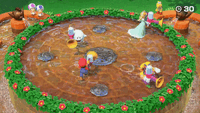
Bodies of water are featured in various minigames from the Mario Party series. Water is typically an obstacle or a medium for players to navigate through, usually by swimming or being on transportation devices ranging from simple rafts to vehicles including boats and submarines. Other times, water is used as a hazard, where players that fall into it are considered eliminated. Other uses of water include watering plants such as in Piranha's Pursuit and in Storm Chasers.
Underwater environments are sometimes the setting of some boards, such as Deep Bloober Sea and Undersea Dream, but the effect is purely aesthetic.
Water is featured in the following minigames, with their roles indicated.
Water as part of player movement[edit]
- Treasure Divers – Mario Party, Super Mario Party Jamboree
- Tightrope Treachery – Mario Party (team)
- Paddle Battle – Mario Party
- Coin Shower Flower – Mario Party
- Deep Sea Divers – Mario Party
- Deep Sea Salvage – Mario Party 2
- Bob-omb Barrage – Mario Party 2
- Torpedo Targets – Mario Party 2
- Cheep Cheep Chase – Mario Party 3, Mario Party Superstars
- Water Whirled – Mario Party 3
- Spotlight Swim – Mario Party 3, Mario Party Superstars (solo player)
- River Raiders – Mario Party 3, Mario Party Superstars
- Hand, Line and Sinker – Mario Party 3 (team)
- Ridiculous Relay – Mario Party 3 (team)
- Puddle Paddle – Mario Party 3, Mario Party Superstars
- Dizzy Dinghies – Mario Party 3
- Manta Rings – Mario Party 4
- Mario Medley – Mario Party 4
- Right Oar Left? – Mario Party 4
- Pair-a-sailing – Mario Party 4
- Cheep Cheep Sweep – Mario Party 4
- Hydrostars – Mario Party 5
- Submarathon – Mario Party 5
- Treasure Trawlers – Mario Party 6
- Blooper Scooper – Mario Party 6
- Cash Flow – Mario Party 6
- Sink or Swim – Mario Party 6 (team)
- See Monkey? – Mario Party Advance
- Bubble Brawl – Mario Party 7
- Be My Chum! – Mario Party 7 (team)
- Mad Props – Mario Party 7
- Fish & Cheeps – Mario Party 7
- Synch-row-nicity – Mario Party 7
- Water Ski Spree – Mario Party 8
- Rowed to Victory – Mario Party 8
- Lean, Mean Ravine – Mario Party 8
- Raft Riot – Mario Party DS
- Rubber Ducky Rodeo – Mario Party DS
- Cheep Chump – Mario Party DS
- Pianta Pool – Mario Party 9
- Ring Leader – Mario Party 9
- Ballistic Beach – Mario Party 9
- Cheep Cheep Shot – Mario Party 9
- Sub Trouble – Mario Party: Island Tour
- Paddle Skedaddle – Mario Party: Island Tour
- Pool Buoy – Mario Party: Island Tour
- Fruit of the Doom – Mario Party 10
- Rapid River Race – Mario Party 10, Mario Party Superstars
- Blooper Blastoff – Mario Party 10
- Blowboat Battle – Mario Party: Star Rush
- Bumper Bugs – Mario Party: Star Rush
- Steal Diver – Mario Party: Star Rush
- Rowboat Uprising – Super Mario Party
- Tiny Triathlon – Super Mario Party Jamboree
- Cage Catch – Super Mario Party Jamboree (solo)
- Income Stream – Super Mario Party Jamboree
- Dorrie Pedal-Paddle – Super Mario Party Jamboree
- Dragoneel Slayers – Super Mario Party Jamboree
Water as an obstacle[edit]
- Spotlight Swim – Mario Party 3, Mario Party Superstars (team)
- Tidal Toss – Mario Party 3, Mario Party: Top 100, Mario Party Superstars (team)
- Dorrie Dip – Mario Party 3
- Take a Breather – Mario Party 4
- Flower Shower – Mario Party 5
- Tidal Fools – Mario Party DS
- Cheep Diamonds – Mario Party: Island Tour
Water as a falling penalty[edit]
- Frigid Bridges – Mario Party 3
- Unhappy Trails – Mario Party 7
- Polar Extreme – Mario Party 9
- Go with the Floe – Mario Party: Island Tour
- Daisy's Field Day – Super Mario Party Jamboree
Water as an elimination hazard[edit]
- Bumper Balls – Mario Party, Mario Party 2, Mario Party Superstars
- Bombs Away – Mario Party, Mario Party 2, Mario Party: The Top 100, Mario Party Superstars
- Shy Guy Says – Mario Party, Mario Party: The Top 100, Mario Party Superstars
- Mushroom Mix-Up –Mario Party, Mario Party Superstars
- Hammer Drop –Mario Party, Mario Party Superstars
- Tightrope Treachery – Mario Party (solo player)
- Bumper Ball Maze – Mario Party
- Abandon Ship – Mario Party 2
- Swinging with Sharks – Mario Party 3, Mario Party Superstars
- Makin' Waves – Mario Party 4 (solo)
- Pushy Penguins – Mario Party 5, Mario Party: Top 100, Mario Party Superstars
- Tug-o-Dorrie – Mario Party 5
- Daft Rafts – Mario Party 6
- Wrasslin' Rapids – Mario Party 6
- Tally Me Banana – Mario Party 6
- Melon Folley – Mario Party Advance
- Spray Anything – Mario Party 7 (solo)
- Balloonatic – Mario Party 7 (solo)
- Air Farce – Mario Party 7
- The Final Countdown – Mario Party 7, Mario Party: Top 100, Mario Party Superstars
- Gimme a Sign – Mario Party 7
- Bridge Work – Mario Party 7
- Glacial Meltdown – Mario Party 8
- Flagging Rights – Mario Party 8
- Power Washer – Mario Party DS
- Polar Extreme – Mario Party 9
- Slip 'n' Slip – Mario Party: Island Tour
- Bouncy Brawl – Mario Party 10
- Bullet Bill Bullies – Mario Party 10
- Soak or Croak – Super Mario Party
- Lumber Tumble – Super Mario Party Jamboree
- Cold Front – Super Mario Party Jamboree
- Sled to the Edge – Super Mario Party Jamboree
Water for fishing[edit]
- Cast Aways – Mario Party, Mario Party Superstars
- Deep Sea Divers – Mario Party
- Hand, Line and Sinker – Mario Party 3 (solo)
- Rumble Fishing – Mario Party 4
- Fish Sticks – Mario Party 5
- Cast Away Mario! – Mario Party-e
- Reel Cheep – Mario Party Advance
- Cheep Cheep Chance – Mario Party DS
- Pier Pressure – Mario Party 9, Mario Party: Top 100
- Cheepers Keepers – Mario Party: Island Tour
- Cheep Cheep Reach – Mario Party: Star Rush
- Rumble Fishing – Super Mario Party
- Fast Fishing – Super Mario Party Jamboree
Miscellaneous[edit]
- Piranha's Pursuit – Mario Party, Mario Party: The Top 100, Mario Party Superstars (rain grows Piranha Plant and Petey Piranha)
- Hyper Hydrants – Mario Party 3 (hose puts out fire)
- Storm Chasers – Mario Party 3, Mario Party Superstars (rain waters and grows Piranha Plant)
- Fish n' Drips – Mario Party 4 (water is used to fill a container to put a Cheep Cheep inside)
- Ground Pound Down – Mario Party 5 (goal of the minigame)
- Garden of Eatin' – Mario Party: Island Tour (players water a Piranha Plant)
- Precision Gardening – Super Mario Party (players water a plant)
- Net Worth – Super Mario Party (players use a net to lift Cheep Cheep from water)
- Chomp Wash – Super Mario Party Jamboree (players spray water to clean a Chain Chomp)
Paper Mario series[edit]
Paper Mario[edit]
In Paper Mario, water cannot be entered or even jumped over unless Mario is riding Sushie, who allows him to swim over the surface and briefly dive beneath the surface. Mario can only start riding Sushie while standing on wooden docks, so not all bodies of water can be traversed this way.
Sushie's Squirt and Tidal Wave moves involve her using water to attack enemies and have a water-elemental property, which allows them to deal additional damage to fiery enemies such as Lava Bubbles. Similarly, Sushie's Water Block move provides additional protection to Mario against fire-based attacks due to its water-based nature.
Paper Mario: The Thousand-Year Door[edit]
In Paper Mario: The Thousand-Year Door, Mario can safely jump over water. However, if he lands in water, he is invariably attacked by Nibbles, damaging him and forcing him back onto land, unless he is in Boat Mode. Boat Mode can only be activated while Mario is standing on special boat panels, similarly to Sushie's wooden docks, so much like in Paper Mario not all bodies of water can be safely traversed.
Bowser's World 2 platforming level features him underwater. While underwater, Bowser cannot jump out and is able to breathe fire at any height.
Super Paper Mario[edit]
In Super Paper Mario, much of The Tile Pool takes place underwater. Smaller bodies of water appear elsewhere in the game: Flipside and Flopside have an underwater canal, Gloam Valley has platforms floating in a pool of water, the Gap of Crag has a river, and The Underwhere has the River Twygz. Underwater controls are similar to the Super Mario series, although Brick Blocks cannot be broken by hitting them from below.
Paper Mario: Sticker Star[edit]
In Paper Mario: Sticker Star, water again is an impassible portion of the terrain, forming invisible walls. Mario does not gain any ability or any ally that allows him to enter water in the field. In this game, filled bodies of water have a shiny texture.
Water is used in additional ways in some courses. Water's Edge Way has water coming from a Bowser-shaped fountain head that flows down into a cave then back out through a different opening as a geyser. This water both prevents entry to the cave and prevents the player from reaching the scrap form of a Comet Piece that Kamek tosses away earlier in the course such that it lands on top of the geyser. The fountain head is powered by water coming through the Faucet, which is hidden in another cave, and collecting the Faucet causes the flow to drain into a separate grate. This stops the water from coming out of the fountain head, meaning there is no water to block the cave and carry the Comet Piece, enabling Mario to collect the Comet Piece to use later on to complete the course. The Faucet can be placed on a vessel of water in Damp Oasis through paperization, which causes the water to flow out of the vessel through the Faucet and flood the screen. When the water recedes, the area is restored from a barren desert to a lush oasis. A Toad there switches into swim trunks during the cutscene so that they can relax in the oasis, and is in such a hurry to do that they do not lock the door to their house after they leave. This is a necessary part of progression, as the house contains a treasure chest that contains a Tablet Piece. In Rugged Road, Mario can enter the Bubbling Waters Natural Hot Springs to recover HP. Kersti notes she cannot enter the hot spring, because she is a sticker.
Cheep Cheeps and the Big Cheep Cheep spray water as an attack, which can make Mario Soggy. The Squirt Gun, Watering Can, Faucet, and Teapot all attack opponents with water, possibly inflicting Soggy on them. The first of these sprays down enemies one at a time, while the remaining three flood the screen to damage all enemies at once.
Surfshine Harbor connects to the Decal Channel, which is the only way to reach World 4, World 5, and World 6. Mario has to get a boat from Surfshine Harbor to be able to enter the Decal Channel and proceed to these worlds.
In World 3, most of the water in the forest is corrupted by poison, which contradictorily makes it enter-able since it is poison and not water. Once Gooper Blooper, the boss of World 3 and the source of the poison, is defeated, all the poison goes away. Note that water does not return; all the passages poison occupied become empty. The lone exception is a hot spring in Tree Branch Trail, which has water again and can be entered.
Paper Mario: Color Splash[edit]
In Paper Mario: Color Splash, Cobalt Base has an underwater section, with Mario floating in a bubble. If he loses Snifit or Whiffit, a Big Urchin pops the bubble, leading him to drown. Fort Cobalt takes place at a port, with Ludwig attacking Mario with his Super Ludship and Super Ludsub on the water.
In Cherry Lake, a Shy Guy gets caught on a waterwheel and dipped underwater, turning into a Soggy Guy. Water surrounds the Indigo Underground, Sunglow Ridge, and Château Chanterelle, as well as the hot springs in the Redpepper Crater. At Bloo Bay Beach, Mario can walk in shallow water.
The ocean is drained of color and needs the blue Big Paint Star to fill it in. After it is cleared, Mario and the Violet Passage captain's crew set sail to Fortune Island, stopping at Vortex Island and Lighthouse Island along the way.
Plum Park is initially flooded with poisonous water that harms Mario if he stays in it, needing a bucket to safely traverse it. After Petea Piranha's defeat, the water is purified and Mario can enter it normally.
Mario & Luigi series[edit]
Mario & Luigi: Superstar Saga / Mario & Luigi: Superstar Saga + Bowser's Minions[edit]
In Mario & Luigi: Superstar Saga and its remake Mario & Luigi: Superstar Saga + Bowser's Minions, the entirety of the Seabed and parts of Gwarhar Lagoon are located underwater. Underwater areas are always connected to the surface via yellow Warp Pipes that Mario & Luigi can ascend by climbing up them. While Mario and Luigi move sluggishly in the overworld while underwater, it does not affect their Firebrand and Thunderhand moves, and Mario and Luigi are completely unaffected by water in battle.
While above water, Mario and Luigi can only cross water by Mario surfing using Luigi as a surfboard, which requires Mario to hammer Luigi using the Dunk Hammer move into metal slots called Surfing Spots located near water. These slots are only accessible after Mario and Luigi have the Ultra Hammers.
Mario & Luigi: Bowser's Inside Story / Mario & Luigi: Bowser's Inside Story + Bowser Jr.'s Journey[edit]
In Mario & Luigi: Bowser's Inside Story and its remake Mario & Luigi: Bowser's Inside Story + Bowser Jr.'s Journey, the Sea Pipe Statue begins spraying an endless stream of water once it is defeated. Bowser can drink the water to flood the Pump Works in his body, allowing Mario and Luigi to swim around freely.
Bowser can punch cannonball-like devices in Blubble Lake, which loop around to knock Bowser into the water. While underwater, Bowser's Flame is replaced by swimming upward. There is a cap on how high Bowser can rise, in that he cannot swim above the play area. To return to the surface, Bowser can stand on red clams that are occasionally pushed upward by underwater currents. The force of this current throws Bowser back to land. The only enemies found underwater are Crawfuls.
Bowser can stand on Squid Fit and punch against the terrain, which pushes him and the raft in the opposite direction across the surface of water. They can only move in orthogonal directions. However, Bowser can punch terrain while moving, redirecting him and the Squid Fit. The movement being performed before the punch is fully negated, again because they can only move in orthogonal directions.
Gallery[edit]
- For this subject's image gallery, see Gallery:Water.
Names in other languages[edit]
| Language | Name | Meaning | Notes |
|---|---|---|---|
| Japanese | Mizu |
Water | |
| Chinese | 水[?] Shuǐ |
Water | |
| Dutch | Water[?] | - | |
| French | Eau[?] | Water | |
| German | Wasser[?] | Water | |
| Italian | Acqua[?] | Water | |
| Korean | 물[?] Mul |
Water | |
| Portuguese | Água[?] | Water | |
| Russian | Вода[?] Voda |
Water | |
| Spanish | Agua[?] | Water |
See also[edit]
- Hazardous objects
- Bowser's Fury objects
- Donkey Kong (Game Boy)
- Donkey Kong Jr.
- Mario & Luigi: Bowser's Inside Story objects
- Mario & Luigi: Superstar Saga objects
- Mario Kart World objects
- New Super Luigi U objects
- New Super Mario Bros. objects
- New Super Mario Bros. 2 objects
- New Super Mario Bros. U objects
- New Super Mario Bros. Wii objects
- Super Mario 3D Land objects
- Super Mario 3D World objects
- Super Mario 64 objects
- Super Mario Bros. objects
- Super Mario Bros. 3 objects
- Super Mario Bros.: The Lost Levels objects
- Super Mario Bros. Wonder objects
- Super Mario Galaxy objects
- Super Mario Galaxy 2 objects
- Super Mario Land objects
- Super Mario Land 2: 6 Golden Coins objects
- Super Mario Odyssey objects
- Super Mario Sunshine objects
- Super Mario World objects
- The Super Mario Bros. Movie objects
